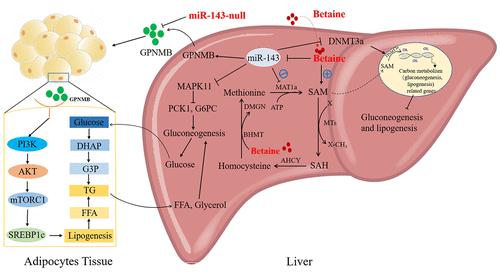当前位置:
X-MOL 学术
›
J. Agric. Food Chem.
›
论文详情
Our official English website, www.x-mol.net, welcomes your
feedback! (Note: you will need to create a separate account there.)
miR-143-Mediated Responses to Betaine Supplement Repress Lipogenesis and Hepatic Gluconeogenesis by Targeting MAT1a and MAPK11
Journal of Agricultural and Food Chemistry ( IF 5.7 ) Pub Date : 2022-06-23 , DOI: 10.1021/acs.jafc.2c02940 Xingping Chen 1 , Junyi Luo 1 , Lekai Yang 1 , Yue Guo 1 , Yaotian Fan 1 , Jie Liu 1 , Jiajie Sun 1 , Yongliang Zhang 1 , Qingyan Jiang 1 , Ting Chen 1 , Qianyun Xi 1
Journal of Agricultural and Food Chemistry ( IF 5.7 ) Pub Date : 2022-06-23 , DOI: 10.1021/acs.jafc.2c02940 Xingping Chen 1 , Junyi Luo 1 , Lekai Yang 1 , Yue Guo 1 , Yaotian Fan 1 , Jie Liu 1 , Jiajie Sun 1 , Yongliang Zhang 1 , Qingyan Jiang 1 , Ting Chen 1 , Qianyun Xi 1
Affiliation

|
The liver as the central organ is responsible for lipogenesis, gluconeogenesis and one-carbon metabolism. Methyl donors (e.g., betaine) modulate metabolic homeostasis and gene regulation through one-carbon metabolism. MiR-143 regulates DNA methylation by targeting DNMT3A, thereby suggesting that this miRNA participates in one-carbon metabolic pathways. However, the effect and mechanism that regulate glucose and lipid metabolism via the methyl group metabolism pathway remain elusive. In this study, we found that a betaine supplement and miR-143 KO significantly promoted lipolysis and glucose utilization and repressed lipogenesis and gluconeogenesis through enhancing energy consumption and thermogenesis, repressing GPNMB and targeting MAPK11, respectively. We further explored the relationship between miR-143 and a methyl donor (betaine) and the miR-143-mediated responses to the betaine supplement regulating the mechanism of the glucose and lipid metabolism. The results showed that betaine significantly down-regulated the expression of miR-143 that subsequently increased SAM levels in the liver by targeting MAT1a. In brief, the regulations of glucose and lipid metabolism are related to the miR-143-regulation of one-carbon units, and the relationship between betaine and miR-143 in the methionine cycle is a typical yin–yang type of regulation. Thus, betaine and miR-143 function together as key regulators and biomarkers for preventing and diagnosing metabolic diseases such as fatty liver disease, obesity, and diabetes.
中文翻译:

miR-143 介导的对甜菜碱补充剂的反应通过靶向 MAT1a 和 MAPK11 抑制脂肪生成和肝糖异生
肝脏作为中枢器官,负责脂肪生成、糖异生和一碳代谢。甲基供体(例如甜菜碱)通过一碳代谢调节代谢稳态和基因调控。MiR-143 通过靶向 DNMT3A 调节 DNA 甲基化,从而表明该 miRNA 参与单碳代谢途径。然而,通过甲基代谢途径调节糖脂代谢的作用和机制仍不清楚。在这项研究中,我们发现甜菜碱补充剂和 miR-143 KO 分别通过增强能量消耗和产热、抑制 GPNMB 和靶向 MAPK11 显着促进脂肪分解和葡萄糖利用并抑制脂肪生成和糖异生。我们进一步探讨了 miR-143 和甲基供体(甜菜碱)之间的关系,以及 miR-143 介导的对甜菜碱补充剂调节葡萄糖和脂质代谢机制的反应。结果表明,甜菜碱显着下调了 miR-143 的表达,随后通过靶向 MAT1a 增加了肝脏中的 SAM 水平。简而言之,糖脂代谢的调控与单碳单元的miR-143调控有关,蛋氨酸循环中甜菜碱与miR-143的关系是典型的阴阳调控。因此,甜菜碱和 miR-143 共同作为关键调节剂和生物标志物,用于预防和诊断代谢疾病,如脂肪肝病、肥胖症和糖尿病。
更新日期:2022-06-23
中文翻译:

miR-143 介导的对甜菜碱补充剂的反应通过靶向 MAT1a 和 MAPK11 抑制脂肪生成和肝糖异生
肝脏作为中枢器官,负责脂肪生成、糖异生和一碳代谢。甲基供体(例如甜菜碱)通过一碳代谢调节代谢稳态和基因调控。MiR-143 通过靶向 DNMT3A 调节 DNA 甲基化,从而表明该 miRNA 参与单碳代谢途径。然而,通过甲基代谢途径调节糖脂代谢的作用和机制仍不清楚。在这项研究中,我们发现甜菜碱补充剂和 miR-143 KO 分别通过增强能量消耗和产热、抑制 GPNMB 和靶向 MAPK11 显着促进脂肪分解和葡萄糖利用并抑制脂肪生成和糖异生。我们进一步探讨了 miR-143 和甲基供体(甜菜碱)之间的关系,以及 miR-143 介导的对甜菜碱补充剂调节葡萄糖和脂质代谢机制的反应。结果表明,甜菜碱显着下调了 miR-143 的表达,随后通过靶向 MAT1a 增加了肝脏中的 SAM 水平。简而言之,糖脂代谢的调控与单碳单元的miR-143调控有关,蛋氨酸循环中甜菜碱与miR-143的关系是典型的阴阳调控。因此,甜菜碱和 miR-143 共同作为关键调节剂和生物标志物,用于预防和诊断代谢疾病,如脂肪肝病、肥胖症和糖尿病。











































 京公网安备 11010802027423号
京公网安备 11010802027423号